Organizational Performance Management and the ‘Sustainability’ of the Performance Evaluation System: A View Guided by the Integrative Review Perspective
Abstract
:1. Introduction
2. Methodology
3. Results
3.1. The Evolution of Performance Evaluation
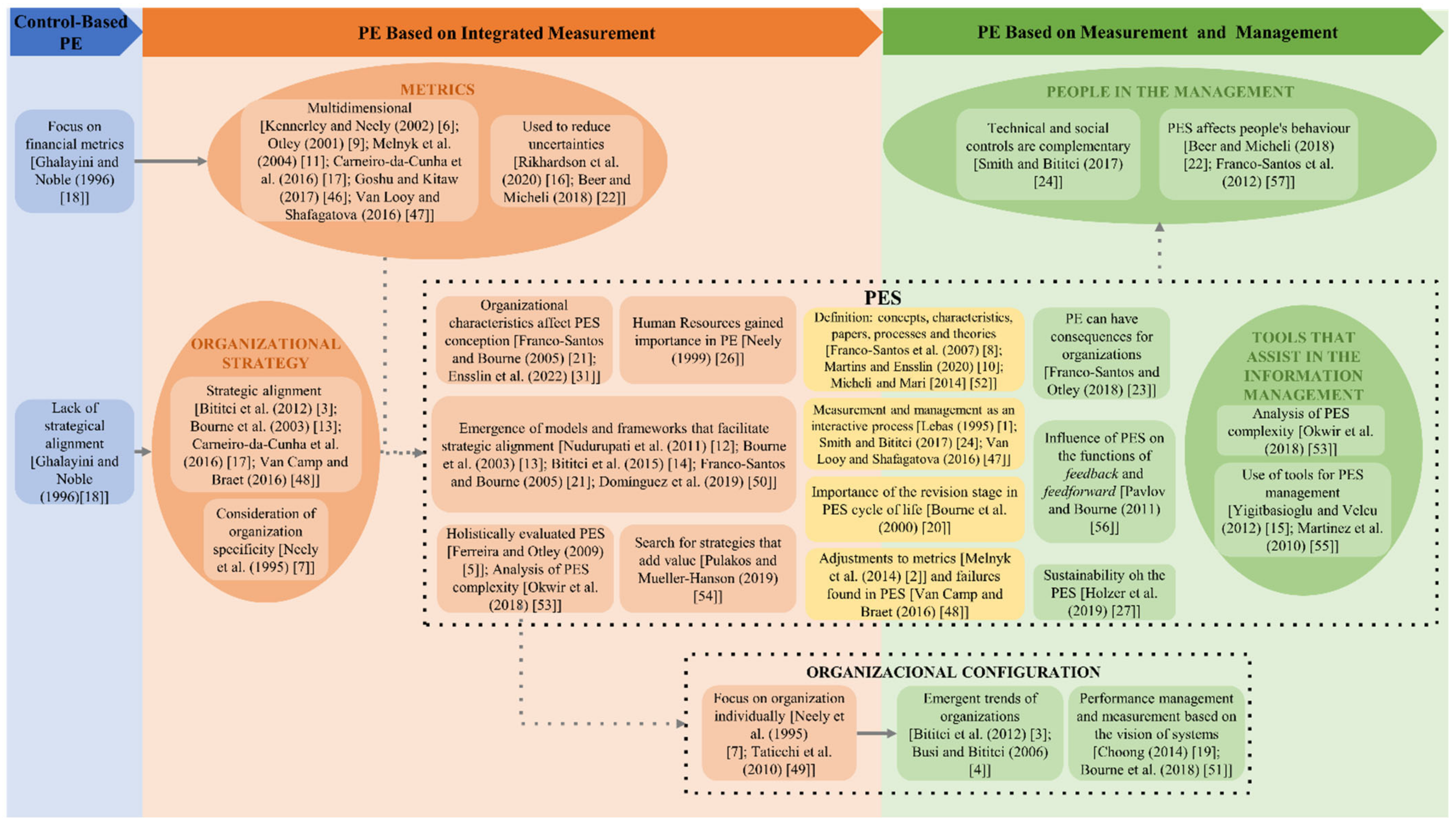
3.2. Organizational Performance Management as a Guiding Concept
3.3. Analysis of Lens Aspects in Relation to the Elements of the Guiding Concept
3.3.1. System-Related Resources
3.3.2. Technical Factors
3.3.3. Human Factor
3.3.4. Culture
3.3.5. Learning
4. Final Considerations
Author Contributions
Funding
Institutional Review Board Statement
Informed Consent Statement
Data Availability Statement
Acknowledgments
Conflicts of Interest
Appendix A. Process of Selection of the Bibliographic Portfolios (BP) on Performance Evaluation (PE)
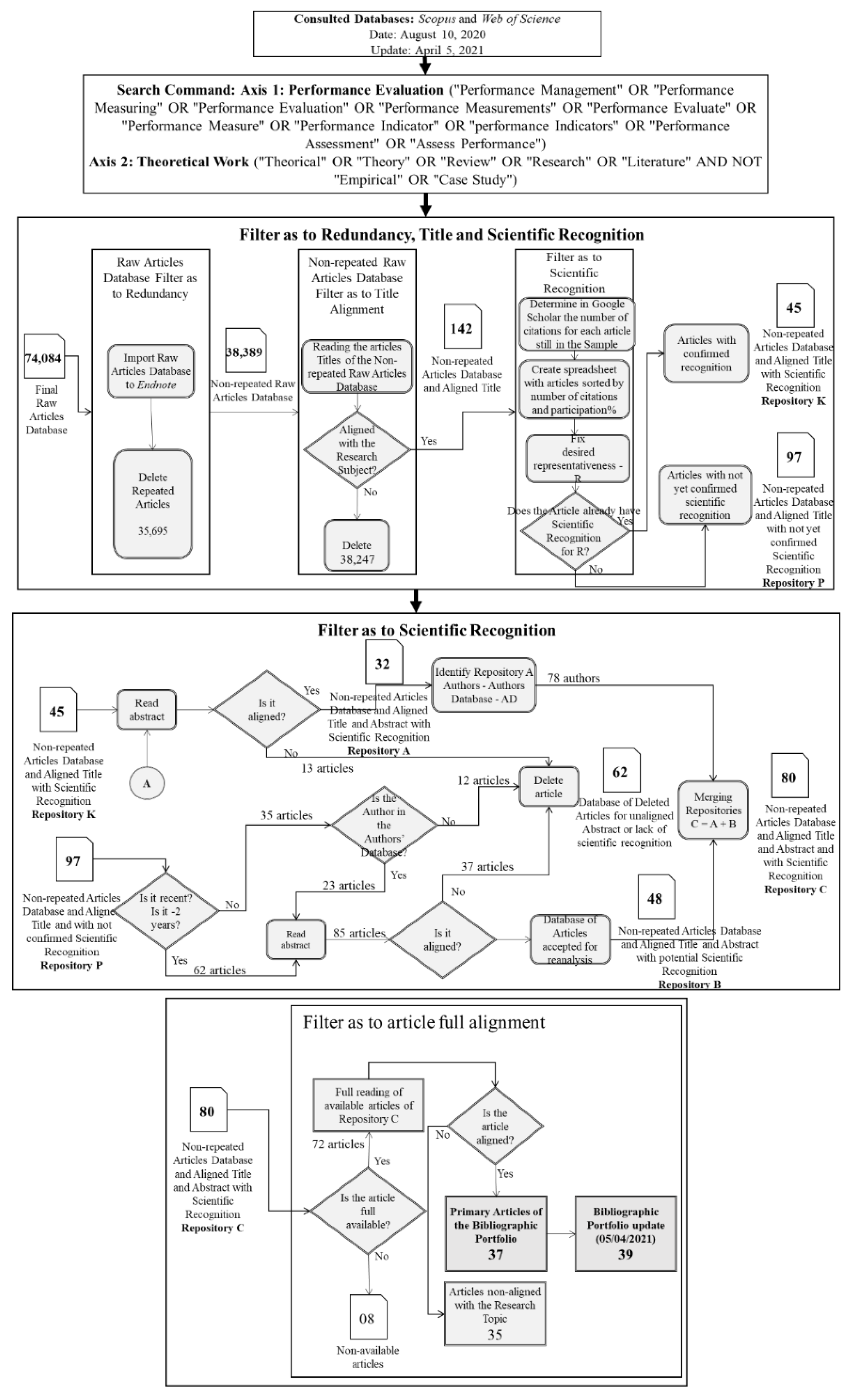
Appendix B. Summary of Journals Selected in the Bibliographic Portfolios on Performance Evaluation
| Journals | Frequency |
| International Journal of Operations & Production Management | 8 |
| International Journal of Business Performance Management | 4 |
| International Journal of Management Reviews | 4 |
| International Journal of Productivity and Performance Management | 4 |
| Management Accounting Research | 4 |
| International journal of Production Research | 3 |
| Production Planning & Control | 2 |
| Annual Review of Organizational Psychology and Organizational Behavior | 1 |
| Computer Standards & Interfaces | 1 |
| Computers & Industrial Engineering | 1 |
| International Journal of Accounting Information Systems | 1 |
| International Journal of Production Economics | 1 |
| International Journal of Public Administration | 1 |
| Journal of Operations Management | 1 |
| Measuring Business Excellence | 1 |
| SpringerPlus | 1 |
| The British Accounting Review | 1 |
References
- Lebas, M.J. Performance measurement and performance management. Int. J. Prod. Econ. 1995, 41, 23–35. [Google Scholar] [CrossRef]
- Melnyk, S.A.; Bititci, U.; Platts, K.; Tobias, J.; Andersen, B. Is performance measurement and management fit for the future? Manag. Account. Res. 2014, 25, 173–186. [Google Scholar] [CrossRef]
- Bititci, U.S.; Garengo, P.; Dörfler, V.; Nudurupati, S. Performance measurement: Challenges for tomorrow. Int. J. Manag. Rev. 2012, 14, 305–327. [Google Scholar] [CrossRef]
- Busi, M.; Bititci, U.S. Collaborative performance management: Present gaps and future research. Int. J. Prod. Perf. Manag. 2006, 55, 7–25. [Google Scholar] [CrossRef]
- Ferreira, A.; Otley, D.T. The design and use of performance management systems: An extended framework for analysis. Manag. Account. Res. 2009, 20, 263–282. [Google Scholar] [CrossRef]
- Kennerley, M.; Neely, A. A framework of the factors affecting the evolution of performance measurement systems. Int. J. Oper. Prod. Manag. 2002, 22, 1222–1245. [Google Scholar] [CrossRef]
- Neely, A.; Gregory, M.; Platts, K. Performance measurement system design: A literature review and research agenda. Int. J. Oper. Prod. Manag. 1995, 15, 80–116. [Google Scholar] [CrossRef]
- Franco-Santos, M.; Kennerley, M.; Micheli, P.; Martinez, V.; Mason, S.; Marr, B.; Gray, D.; Neely, A. Towards a definition of a business performance measurement system. Int. J. Oper. Prod. Manag. 2007, 27, 784–801. [Google Scholar] [CrossRef]
- Otley, D. Extending the boundaries of management accounting research: Developing systems for performance management. Br. Account. Rev. 2001, 33, 243–261. [Google Scholar] [CrossRef]
- Martins, V.A.; Ensslin, S.R. Performance evaluation: What theoretical studies highlight about this theme. Int. J. Bus. Perf. Manag. 2020, 21, 455–476. [Google Scholar] [CrossRef]
- Melnyk, A.S.; Stewart, D.M.; Swink, M. Metrics and performance measurement in operations management: Dealing with the metrics maze. J. Oper. Manag. 2004, 22, 209–218. [Google Scholar] [CrossRef]
- Nudurupati, S.S.; Bititci, U.S.; Kumar, V.; Chan, F.T. State-of-the-art literature review on performance measurement. Comput. Ind. Eng. 2011, 60, 279–290. [Google Scholar] [CrossRef]
- Bourne, M.; Neely, A.; Mills, J.; Platts, K. Implementing performance measurement systems: A literature review. Int. J. Bus. Perf. Manag. 2003, 5, 1–24. [Google Scholar] [CrossRef]
- Bititci, U.S.; Garengo, P.; Ates, A.; Nudurupati, S. Value of maturity models in performance measurement. Int. J. Prod. Res. 2015, 53, 3062–3085. [Google Scholar] [CrossRef]
- Yigitbasioglu, O.M.; Velcu, O. A review of dashboards in performance management: Implications for design and research. Int. J. Account. Inf. Syst. 2012, 13, 41–59. [Google Scholar] [CrossRef]
- Rikhardsson, P.; Wendt, S.; Arnardóttir, A.A.; Sigurjónsson, T.O. Is more really better? Performance measure variety and environmental uncertainty. Int. J. Prod. Perf. Manag. 2021, 70, 1446–1469. [Google Scholar] [CrossRef]
- Carneiro-Da-Cunha, J.A.; Hourneaux, F., Jr.; Corrêa, H.L. Evolution and chronology of the organizational performance measurement field. Int. J. Bus. Perf. Manag. 2016, 17, 223–240. [Google Scholar]
- Ghalayini, A.M.; Noble, J.S. The changing basis of performance measurement. Int. J. Oper. Prod. Manag. 1996, 16, 63–80. [Google Scholar] [CrossRef]
- Choong, K.K. Has this large number of performance measurement publications contributed to its better understanding? A systematic review for research and applications. Int. J. Prod. Res. 2014, 52, 4174–4197. [Google Scholar] [CrossRef]
- Bourne, M.; Mills, J.; Wilcox, M.; Nelly, A.; Platts, K. Designing, implementing and updating performance measurement systems. Int. J. Oper. Prod. Manag. 2000, 20, 754–771. [Google Scholar] [CrossRef]
- Franco-Santos, M.; Bourne, M. An examination of the literature relating to issues affecting how companies manage through measures. Prod. Plan. Cont. 2005, 16, 114–124. [Google Scholar] [CrossRef] [Green Version]
- Beer, H.A.; Micheli, P. Advancing performance measurement theory by focusing on subjects: Lessons from the measurement of social value. Int. J. Manag. Rev. 2018, 20, 755–771. [Google Scholar] [CrossRef]
- Franco-Santos, M.; Otley, D. Reviewing and theorizing the unintended consequences of performance management systems. Int. J. Manag. Rev. 2018, 20, 696–730. [Google Scholar] [CrossRef]
- Smith, M.; Bititci, U.S. Interplay between performance measurement and management, employee engagement and performance. Int. J. Oper. Prod. Manag. 2017, 37, 1207–1228. [Google Scholar] [CrossRef]
- Welter, L.M.; Ensslin, S.R. How do the unintended consequences of performance evaluation systems manifest themselves? J. Account. Org. Chang. 2022, 18, 509–528. [Google Scholar] [CrossRef]
- Neely, A. The performance measurement revolution: Why now and what next? Int. J. Oper. Prod. Manag. 1999, 19, 205–228. [Google Scholar] [CrossRef]
- Holzer, M.; Ballard, A.; Kim, M.; Peng, S.; Deat, F. Obstacles and opportunities for sustaining performance management systems. Int. J. Pub. Admin. 2019, 42, 132–143. [Google Scholar] [CrossRef]
- Torraco, R.J. Writing integrative literature reviews: Guidelines and examples. Hum. Resour. Dev. Rev. 2005, 4, 356–367. [Google Scholar] [CrossRef]
- Lacerda, R.T.O.; Ensslin, L.; Ensslin, S.R. Research opportunities in strategic management field: A performance measurement approach. Int. J. Bus. Perf. Manag. 2014, 15, 158–174. [Google Scholar] [CrossRef]
- Dutra, A.; Ripoll-Feliu, V.M.; Fillol, A.G.; Ensslin, S.R.; Ensslin, L. The construction of knowledge from the scientific literature about the theme seaport performance evaluation. Int. J. Prod. Perf. Manag. 2015, 64, 243–269. [Google Scholar] [CrossRef]
- Ensslin, S.R.; Welter, L.M.; Pedersini, D.R. Performance evaluation: A comparative study between public and private sectors. Int. J. Prod. Perf. Manag. 2022, 71, 1761–1785. [Google Scholar] [CrossRef]
- Staedele, A.E.; Ensslin, S.R.; Forcellini, F.A. Knowledge building about performance evaluation in lean production: An investigation on international scientific research. J. Manufac. Technol. Manag. 2019, 30, 798–820. [Google Scholar] [CrossRef]
- Thiel, G.G.; Ensslin, S.R.; Ensslin, L. Street lighting management and performance evaluation: Opportunities and challenges. Lex Localis. 2017, 15, 303–328. [Google Scholar] [CrossRef]
- Tasca, J.E.; Ensslin, L.; Ensslin, S.R.; Alves, M.B.M. An approach for selecting a theoretical framework for the evaluation of training programs. J. Eur. Ind. Train. 2010, 34, 631–655. [Google Scholar] [CrossRef]
- Ensslin, L.; Ensslin, S.R.; Pinto, H.M. Processo de Investigação e Análise Bibliométrica: Avaliação da Qualidade dos Serviços Bancários. RAC Rev. Adm. Contemporânea 2013, 17, 325–349. [Google Scholar] [CrossRef]
- Bonatto, F.; Resende, L.M.M.; Betim, L.M.; Pereira, R.S.; Agner, T.V. Performance management in horizontal business networks: A systematic review. IFAC-PapersOnLine 2015, 48, 1827–1833. [Google Scholar] [CrossRef]
- Loos, M.J.; Merino, E.; Rodriguez, C.M.T. Mapping the state of the art of ergonomics within logistics. Scientometrics 2016, 109, 85–101. [Google Scholar] [CrossRef]
- Linhares, J.E.; Pessa, S.L.R.; Bortoluzzi, S.C.; Luz, R.P. Capacidade para o trabalho e envelhecimento funcional: Análise sistêmica da literatura utilizando o Proknow-C (Knowledge Development Process—Constructivist). Ciencia Saude Coletiva 2019, 24, 53–66. [Google Scholar] [CrossRef]
- Mite-Albán, M.T.M. Estrategias de contabilidad de gestión aplicada a pymes revisión literaria. Rev. Lasallista Investigación 2018, 15, 256–270. [Google Scholar] [CrossRef]
- Stefano, N.M.; Casarotto Filho, N. Activity-based costing in services: Literature bibliometric review. SpringerPlus 2013, 2, 80. [Google Scholar] [CrossRef]
- Tuesta, Y.N.; Solera, C.C.; Ripoll-Feliu, V.M. Bibliometric and systemic analysis of the relationship between management and carbon. Cuadernos Gestión 2022, 22, 215–228. [Google Scholar] [CrossRef]
- Whittemore, R.; Knafl, K. The integrative review: Update methodology. J. Adv. Nurs. 2005, 52, 546–553. [Google Scholar] [CrossRef] [PubMed]
- Corbin, J.M.; Strauss, A. Grounded theory research: Procedures, canons, and evaluative criteria. Qual. Soc. 1990, 13, 3–21. [Google Scholar] [CrossRef]
- Charmaz, K. The power of constructivist grounded theory for critical inquiry. Qual. Inq. 2017, 23, 34–45. [Google Scholar] [CrossRef]
- Charmaz, K. Constructing Grounded Theory: A Practical Guide through Qualitative Analysis, 1st ed.; SAGE: London, UK, 2006; pp. 42–70. [Google Scholar]
- Goshu, Y.Y.; Kitaw, D. Performance measurement and its recent challenge: A literature review. Int. J. Bus. Perf. Manag. 2017, 18, 381–402. [Google Scholar] [CrossRef]
- Van Looy, A.; Shafagatova, A. Business process performance measurement: A structured literature review of indicators, measures and metrics. SpringerPlus 2016, 5, 1797. [Google Scholar] [CrossRef]
- Van Camp, J.; Braet, J. Taxonomizing performance measurement systems’ failures. Int. J. Prod. Perf. Manag. 2016, 65, 672–693. [Google Scholar] [CrossRef]
- Taticchi, P.; Tonelli, F.; Cagnazzo, L. Performance measurement and management: A literature review and a research agenda. Measur. Bus. Excel. 2010, 14, 4–18. [Google Scholar] [CrossRef]
- Domínguez, E.; Pérez, B.; Rubio, A.L.; Zapata, M.A. A taxonomy for key performance indicators management. Comput. Stand. Interf. 2019, 64, 24–40. [Google Scholar] [CrossRef]
- Bourne, M.; Franco-Santos, M.; Micheli, P.; Pavlov, A. Performance measurement and management: A system of systems perspective. Int. J. Prod. Res. 2018, 56, 2788–2799. [Google Scholar] [CrossRef]
- Micheli, P.; Mari, L. The theory and practice of performance measurement. Manag. Account. Res. 2014, 25, 147–156. [Google Scholar] [CrossRef]
- Okwir, S.; Nudurupati, S.S.; Ginieis, M.; Angelis, J. Performance measurement and management systems: A perspective from complexity theory. Int. J. Manag. Rev. 2018, 20, 731–754. [Google Scholar]
- Pulakos, E.D.; Mueller-Hanson, R.; Arad, S. The evolution of performance management: Searching for value. Annu. Rev. Org. Psychol. Org. Behav. 2019, 6, 249–271. [Google Scholar] [CrossRef]
- Martinez, V.; Pavlov, A.; Bourne, M. Reviewing performance: An analysis of the structure and functions of performance management reviews. Prod. Plan. Cont. 2010, 21, 70–83. [Google Scholar] [CrossRef]
- Pavlov, A.; Bourne, M. Explaining the effects of performance measurement on performance: An organizational routines perspective. Int. J. Oper. Prod. Manag. 2011, 31, 101–122. [Google Scholar] [CrossRef]
- Franco-Santos, M.; Lucianetti, L.; Bourne, M. Contemporary performance measurement systems: A review of their consequences and a framework for research. Manag. Account. Res. 2012, 23, 79–119. [Google Scholar] [CrossRef] [Green Version]
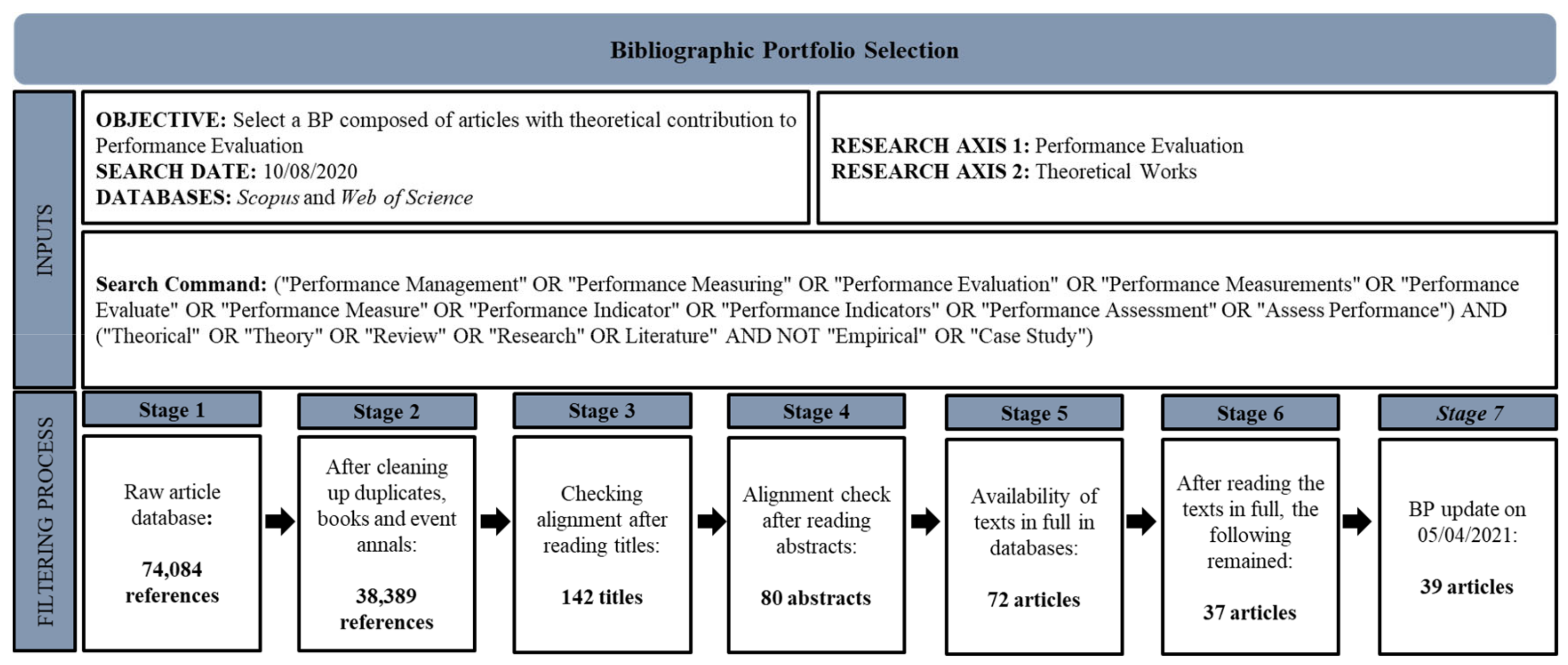
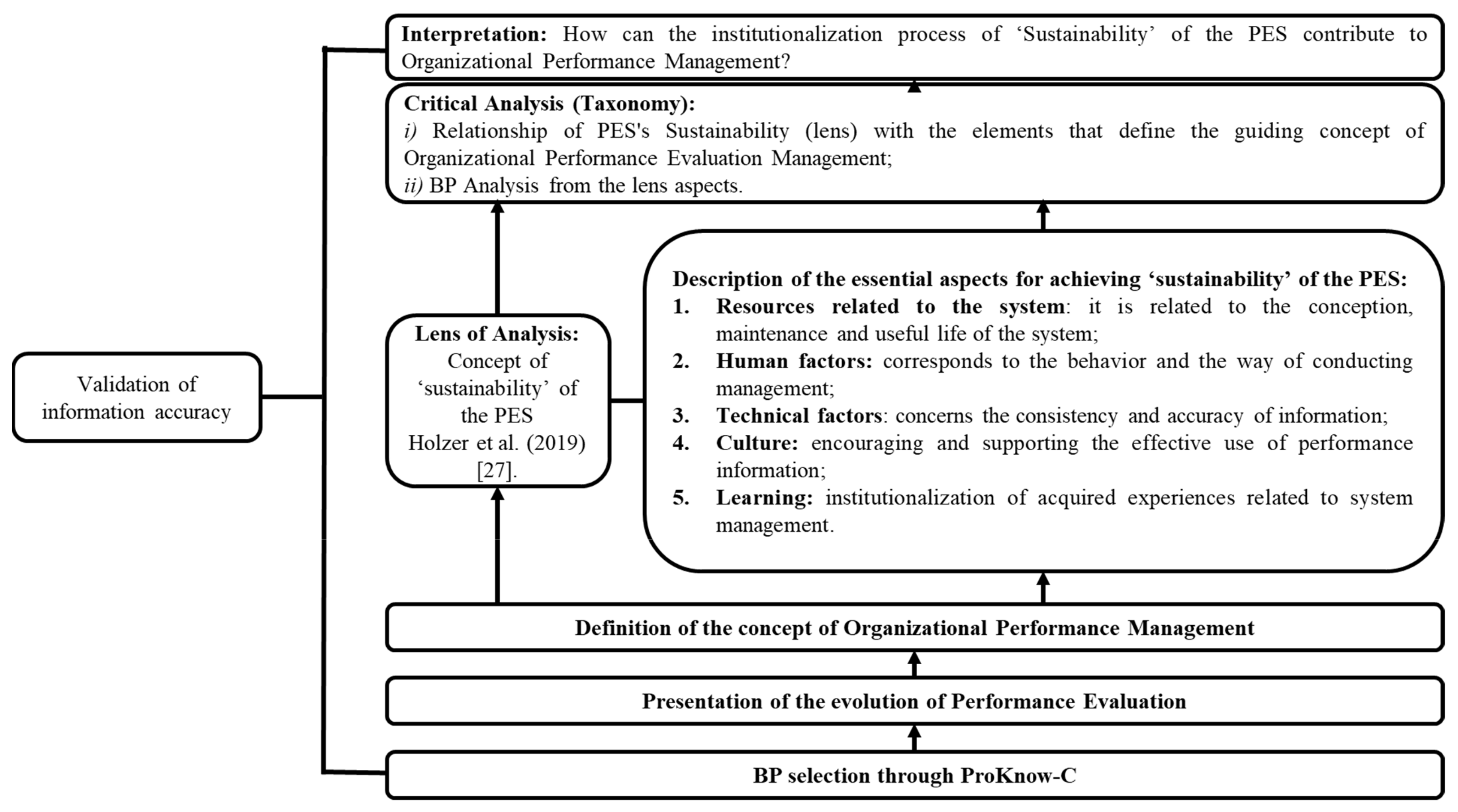
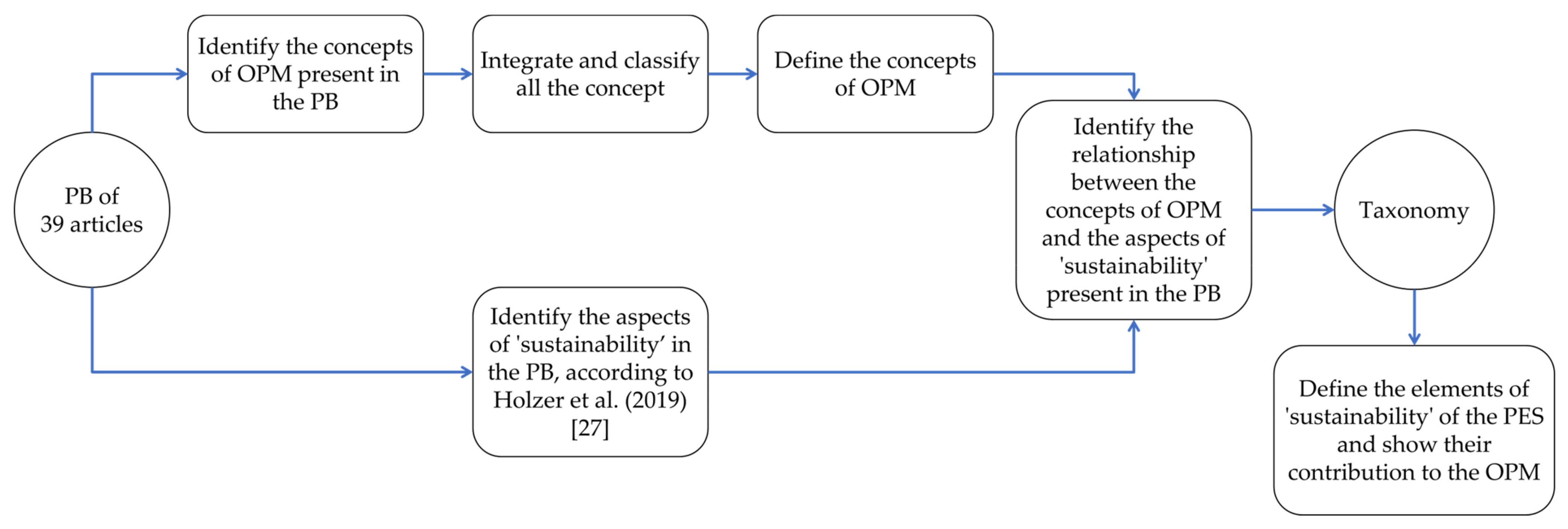
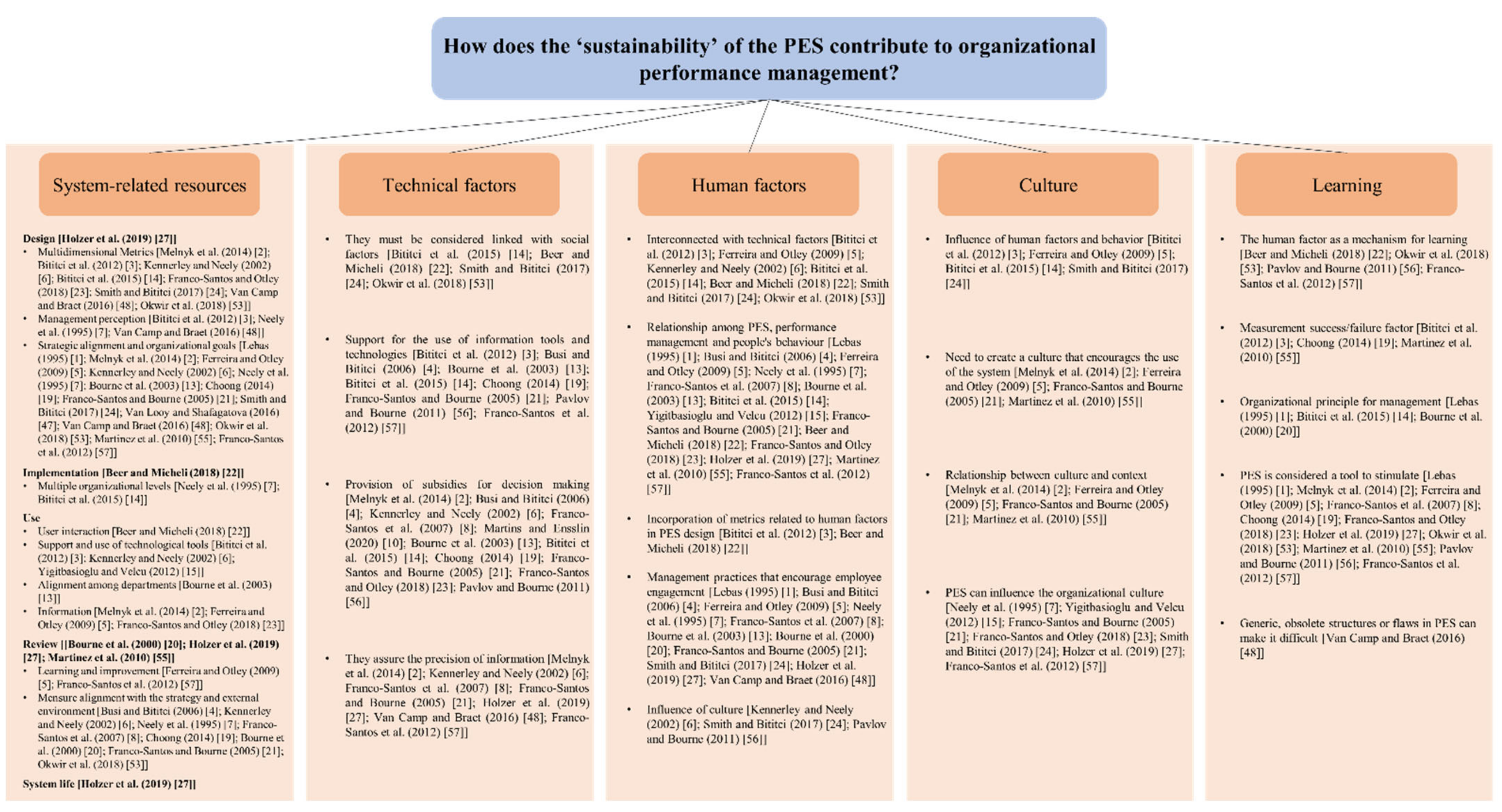
| Element | Definition | References |
|---|---|---|
| Process | Related to considering management as a process. | [2,3,4,5,8,9,14,15,19,20,23,27,48,51,55,56,57] |
| Culture and behaviour | Related to organizational culture, social aspects, people’s behaviour, and the way in which this impacts organizational learning. | [3,4,5,7,8,13,14,19,20,21,22,23,24,27,51,54,57] |
| Routines and practices | Related to all routines and management practices, such as the elaboration of metrics and action strategy, internal and external communication, among others. | [2,4,5,7,10,14,19,22,23,24,27,31,48,55,56,57] |
| Holistic/integrated view | Related to considering the organizational dimensions in an integrated way, as well as performing the organization evaluation holistically. | [1,2,3,4,5,14,15,22,24,27,31] |
| Context and strategic alignment | Related to considering the particularities of the organization in order to enable its strategic alignment. | [1,2,4,7,12,14,15,19,22,31,48,51,53,54,55,56] |
| Decision-making | Related to all aspects that feed decision-making, such as resource allocation, information management, and knowledge, among others. | [1,2,3,4,5,6,8,9,10,14,15,19,21,22,23,24,27,31,48,51,54,55,56,57] |
| Continuous improvement | Related to the improvement and sustainability of organizational performance and its system. | [2,5,7,19,27,55,56,57] |
| Process | Culture and Behaviour | Routines and Practices | Integrated Holistic Vision | Context and Strategic Alignment | Decision-Making | Continuous Improvement | |
|---|---|---|---|---|---|---|---|
| System-related resources | [1,2,3,5,6,7,13,14,15,19,21,22,23,27,47,48,53,55] | [1,2,4,5,7,8,10,13,14,19,20,21,22,23,24,27,47,48,53,55,57] | [1,2,3,4,5,6,7,8,13,14,15,20,21,22,23,27,57] | ||||
| Technical factors | [2,4,5,6,8,10,14,15,19,21,22,23,24,27,48,55,56] | [2,4,5,14,15,22,23,27,50,56,57] | [2,3,4,5,6,8,10,14,15,19,21,22,23,27,48,53,55,56,57] | ||||
| Human factor | [1,4,5,6,7,8,13,14,15,20,21,22,23,24,27,48,53,55,56,57] | [3,5,14,22,23,55,57] | [1,3,5,14,15,23,24,48] | [1,7,24,55,56] | |||
| Culture | [2,3,4,5,6,14,15,21,23,24,27,48,57] | [2,4,5,6,14,15,27,48,55,57] | [3,4,14,23] | [2,3,4,5,21,23,55] | [2,7,15,24,27,56] | ||
| Learning | [3,5,14,19,23,27,57] | [1,14,19,20,22,23,27,48,53,56,57] | [1,5,8,10,14,20,22,23,27,53,56,57] | [1,14,19,53,57] | [3,8,23,48,57] | [1,2,3,5,8,10,14,55,56,57] | [1,2,8,10,19,20,22,23,27,53,55,56] |
| Elements of Organizational Performance Management | Research Agenda |
|---|---|
| Process |
|
| Integrated/holistic vision |
|
| Context and strategic alignment |
|
| Continuous improvement |
|
Publisher’s Note: MDPI stays neutral with regard to jurisdictional claims in published maps and institutional affiliations. |
© 2022 by the authors. Licensee MDPI, Basel, Switzerland. This article is an open access article distributed under the terms and conditions of the Creative Commons Attribution (CC BY) license (https://creativecommons.org/licenses/by/4.0/).
Share and Cite
Ensslin, S.R.; Rodrigues, K.T.; Yoshiura, L.J.M.; da Silva, J.C.; Longaray, A.A. Organizational Performance Management and the ‘Sustainability’ of the Performance Evaluation System: A View Guided by the Integrative Review Perspective. Sustainability 2022, 14, 11005. https://doi.org/10.3390/su141711005
Ensslin SR, Rodrigues KT, Yoshiura LJM, da Silva JC, Longaray AA. Organizational Performance Management and the ‘Sustainability’ of the Performance Evaluation System: A View Guided by the Integrative Review Perspective. Sustainability. 2022; 14(17):11005. https://doi.org/10.3390/su141711005
Chicago/Turabian StyleEnsslin, Sandra Rolim, Kassia Tonheiro Rodrigues, Luiz Junior Maemura Yoshiura, Jessica Carvalho da Silva, and André Andrade Longaray. 2022. "Organizational Performance Management and the ‘Sustainability’ of the Performance Evaluation System: A View Guided by the Integrative Review Perspective" Sustainability 14, no. 17: 11005. https://doi.org/10.3390/su141711005
APA StyleEnsslin, S. R., Rodrigues, K. T., Yoshiura, L. J. M., da Silva, J. C., & Longaray, A. A. (2022). Organizational Performance Management and the ‘Sustainability’ of the Performance Evaluation System: A View Guided by the Integrative Review Perspective. Sustainability, 14(17), 11005. https://doi.org/10.3390/su141711005






